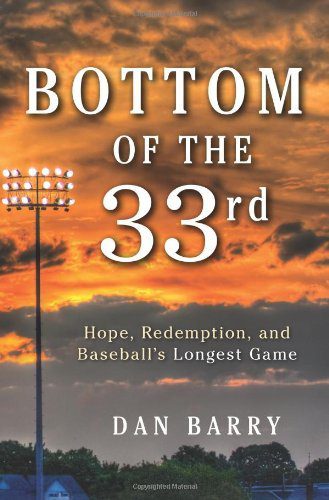
Editor’s note: This is a review of Dan Barry’s “Bottom of the 33rd” (HarperCollins, 2011).
 I’ve spent the last three weeks in Ireland, paying a lot more attention to Gaelic football and hurling than to baseball, which receded in importance as the days went by in County Kerry.
I’ve spent the last three weeks in Ireland, paying a lot more attention to Gaelic football and hurling than to baseball, which receded in importance as the days went by in County Kerry.
For 20 years, I’ve been leading these annual student study tours to Ireland for the University of South Florida in Tampa, where I teach. So I’ve been to Ireland often enough to have developed a great respect for the country’s two national pastimes. Gaelic football is one of those, a sport that is, to American eyes, a cross between rugby and soccer.
Hurling is the other, a sport that bears a resemblance to lacrosse and field hockey, with some pronounced baseball skills added in as players toss the sliotar (about the size, shape and hardness of a baseball) into the air and take a baseball swing at it with the hurley (a shorter version of a hockey stick with a wider blade at the bottom). In both games you can score a single point by getting the ball or slither through the uprights, and three points by getting it into the soccer-style net below the uprights. The action is constant, the skills are really quite amazing, and the crowds fill Croke Park, the national stadium in Dublin, for the last few rounds of the annual All-Ireland championships.
And the players, for all their prominence and heroics, are all amateurs. But more about that some other day, perhaps.
At the moment, I’m again thinking about baseball, where I’ve kept in touch with the game not through the Internet but by reading Dan Barry’s excellent book about a classic minor-league game, “Bottom of the 33rd.” Barry’s book has been my reading material on the long flight home, bringing me back to our national pastime in just about the best possible way, reminding me of my lucky childhood as the son of an ex-major leaguer who turned his skills to minor-league managing once his playing days were done. I loved the minor leagues in those days and love them still, my most recent infatuation being with the storied Buffalo Bisons of the International League. I saw a lot of Bisons baseball in the years we lived near Buffalo.
Barry’s book describes and discusses the famous longest game in baseball history, between the Pawtucket Red Sox and the Rochester Red Wings on Easter weekend of 1981.
Barry begins the story with the usual baseball scene-setting: the weather was cold, the crowd was small, the stadium was rickety and worn, the players a mixture of the ambitious young and the desperately old. Pawtucket was and is a tough town. Rochester was, in those days, still thriving. There are a lot of the usual metaphors to be found in this particular game, along with plenty of social commentary and a great dose of baseball philosophy. I’m a sucker for all those things, and especially for intelligent ruminations on the hard realities of baseball, the true stories behind the romantic versions of the game that we all fall prey to.
Sure, minor-league baseball is a wonderful game, full of promise and hope and filled with future stars. But minor-league baseball – and triple-A baseball in particular – is an impatient, impermanent place, as well; with just about all the players headed up, or down, or out.
And that’s what Barry gives us in “Bottom of the 33rd,” the players’ sense of hope and fear, the gritty realism for some of them that the dream is coming to an end, the confidence of others that the future is bright and the majors beckon. Barry gets personal with the participants in this, weaving in the backstory behind a number of players, coaches, staff, wives and families, broadcasters and more. It’s a terrific technique, following a rough timeline of the game while breaking away often to tell us about, for instance, Pawtucket player Dave Koza, who is at the heart of the story.

Koza was, in those days, a marginal player struggling to move up from triple-A. He’d had his moments, starting with his signing at age 19 by scout Danny Doyle for $15,000 and then moving up from rookie ball in Elmira to single-A in Winter Haven to double-A in Bristol and then triple-A in Pawtucket. He had enough power for 18 home runs each of his two seasons at Pawtucket, with a batting average that ranged from .259 to .268. He was a good, solid ballplayer, but not quite good enough, it seemed, to take that last, final, step up the ladder.
Barry tells Koza’s story with a grace and honesty that comes from a wealth of reporting and a wonderful sense of style. I fold over the corner of pages of books like this, those where the writing so impresses me that I want to underline and note the page and learn from the writer’s skill. I folded over some thirty pages of my paperback edition of “Bottom of the 33rd,” and could have folded a lot more. It’s a book I plan to teach now, so my students who love writing, and the beauty of the written word, can see how any sport – but especially baseball, and especially the minor leagues – can be a source for inspired writing. It is the game on its margins, and the players who struggle there, that make for something worth writing about. Writers, storytellers, need conflict and in minor-league baseball there are conflicts aplenty, most of them centered on the struggle to survive professionally.
My father, Del Wilber, was a marginal player, too, though he made it to the big leagues and stuck around for most of eight seasons, accumulating about one season’s worth of statistics over those years as a bullpen catcher and a pinch-hitter. But his career on the bench opened the doors for him as a triple-A manager where he enjoyed some success and we, his lucky children, got to revel in being the manager’s children in places like Louisville and Charleston, W. Va.
Dad had his struggles, with alcohol and with the bad breaks that are part of the game. In 1973, he won the Pacific Coast League pennant with the Spokane Indians and when the parent club, the Texas Rangers, fired manager Whitey Herzog in September of that year they brought Del Wilber to Arlington to be the interim manager. This was the brass ring that Dad and his wife and all of his children had expected he’d be able to grab sooner or later. He’d paid his dues and now here he was, a big-league manager.
But baseball is as cruel a game as it is a beautiful one, and while Dad won that game when the Rangers came from behind to win, he didn’t stay long in his managerial role. After the game, Rangers’ owner Bob Short announced that Billy Martin had been named as the new manager of the Rangers and Dad came home to us in St. Louis. He never got another chance for a big-league job, and he drifted into bourbon and less ambitious jobs after that, back to minor-league managing and getting fired from that, then scouting, then, happily I think, into retirement, where he became a local celebrity, a great storyteller, in St. Louis and, later and sober, in St. Petersburg, where I was his caregiver in the last, hard, year of his life. That’s a story I told in “My Father’s Game: Life, Death, Baseball” (McFarland, 2007).
So you can see how the story resonates for me as Dave Koza, too, has his one moment in the sun, if at the triple-A level. In the bottom of the 33rd inning of that epic struggle between the Pawtucket Red Sox and the Rochester Red Wings, Koza got the bat on the ball and looped one to third. As Barry describes it: “The softly hit ball flutters past the runner on third base, Marty Barrett, who stutters in place as he tries to discern its destination and meaning. It floats in a tease over the head of the helpless third baseman, Cal Ripken Jr., whose major-league career has yet to being, and descends well in front of the defeated left fielder, Keith Smith, whose major-league career has already passed. Then, having served its purpose, the ball falls to deliver a good-night kiss to the grass.”
And so Dave Koza is the game’s hero. He has his moment. He wins the longest game ever played in organized baseball and earns his way into an exhibit in Cooperstown.
But that’s it for Koza. There is no major-league future for him, there’s just alcohol, a divorce, a steep decline rescued finally, years later, by sobriety: those are in his future, and Barry honors that struggle and Koza’s redemption, which comes in the great tradition of baseball literature.
The subtitle of “Bottom of the 33rd” is this: “Hope, Redemption, and Baseball’s Longest Game.” It’s a great book, you should read it.





